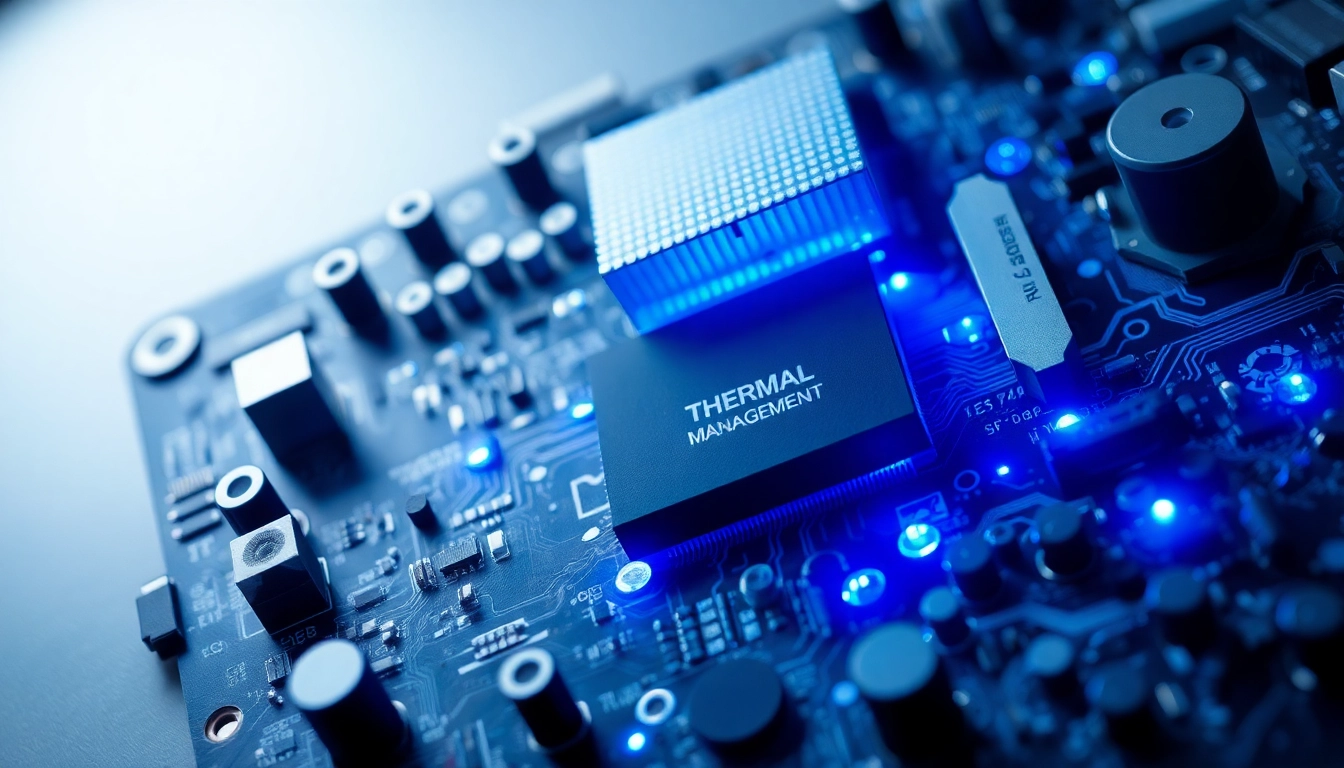Understanding Thermal Management Materials
What Are Thermal Management Materials?
Thermal management materials refer to a broad category of products specifically designed to regulate heat within various applications, most notably in electronics. As electronic devices become more complex and their operational demands increase, effective heat dissipation has emerged as a critical challenge. This encompasses a wide range of materials including thermal interface materials (TIMs), phase change materials (PCMs), thermal adhesives, and gap fillers, among others. These materials not only aid in dissipating excess heat but also help in maintaining optimal operational temperatures, enhancing the performance and longevity of electronic components. For further information, consider exploring this resource on thermal management materials.
Importance of Thermal Management
Efficient thermal management is essential for ensuring the reliability and functionality of electronic devices. Excess heat can lead to various issues such as diminished performance, increased energy consumption, and a shortened device lifespan. Moreover, in high-performance environments such as data centers or electric vehicles, inadequate thermal management could lead to catastrophic failures. Therefore, understanding the principles behind thermal management materials is not just a matter of regulatory compliance but also a key component of design and engineering. By efficiently managing heat, manufacturers can enhance product reliability and improve user satisfaction.
Applications in Electronics
Thermal management materials find application across a myriad of electronic sectors including consumer electronics, telecommunications, automotive industries, and more. In smartphones, for instance, TIMs help bridge the gap between heat-generating components such as processors and heat sinks, facilitating better heat transfer. In electric vehicles, where battery performance and longevity are paramount, effective thermal management is crucial in preventing overheating. Similar principles apply to power electronics in areas like renewable energy systems and aerospace applications.
Types of Thermal Management Materials
Thermal Interface Materials (TIM)
Thermal Interface Materials (TIMs) are crucial for achieving efficient thermal conduction between surfaces. Typically installed between heat-producing components and heat sinks, TIMs fill the microscopic gaps that would otherwise trap air, an inefficient conductor of heat. Available in various forms, including pastes, pads, and tapes, TIMs are engineered to enhance the thermal conductivity, thereby improving performance and efficiency. They are often rated in terms of thermal conductivity, measured in watts per meter-kelvin (W/mK), providing manufacturers with the means to select the right material for their application requirements.
Phase Change Materials (PCM)
Phase Change Materials (PCMs) are designed to absorb, store, and release heat as they change from solid to liquid and vice versa. Their unique property of changing state at specific temperatures makes them superior in managing overheating scenarios, particularly in electronics that experience burst loads. When incorporated into devices, PCMs can maintain a stable operating temperature, significantly reducing the need for active cooling systems. Applications range from mobile devices to larger systems such as energy-efficient buildings.
Conductive Adhesives and Tapes
Conductive adhesives and tapes combine adhesive properties with thermal conductivity, bridging gaps between heat-generating components and heat sinks. They are essential in modern electronics where the volume of traditional mechanical fasteners creates complexity. These adhesives ensure a robust bond while allowing for effective heat transfer, making them ideal for applications in consumer electronics, automotive, and telecommunications. Their versatility also includes being used in the assembly of printed circuit boards (PCBs) and other intricate architectures.
Choosing the Right Thermal Management Material
Key Factors to Consider
When selecting thermal management materials, several factors must be taken into consideration:
- Thermal Conductivity: The heat transfer efficiency is paramount. Evaluate materials based on W/mK ratings to ensure they meet the thermal demands of the application.
- Viscosity and Formulation: Depending on the application, you may require a paste, tape, or pad. The ease of application and the material’s ability to fill gaps are crucial.
- Operating Temperature: Materials need to be able to withstand the maximum operating temperature encountered in use to ensure longevity and reliability.
- Environmental Resistance: Consider factors such as moisture, vibration, and chemical exposure that could impact the performance of the thermal management material.
Performance Metrics Assessment
Evaluation of performance metrics is essential for ensuring the selected thermal management materials will meet the demands of specific applications. Key performance metrics include:
- Thermal Resistance: Lower thermal resistance indicates better performance in heat dissipation.
- Dielectric Strength: Important for preventing electrical shorts, especially in high-voltage electronic applications.
- Compressive Strength: Assures that the material can maintain contact pressure against surfaces during installation.
- Service Life: Assess longevity and reliability under specific environmental conditions.
Common Mistakes to Avoid
Choosing thermal management materials requires careful consideration. Common mistakes include:
- Overlooking Compatibility: Ensure chosen materials are compatible with the components they will contact.
- Neglecting Performance Testing: Even if a material has ideal specifications, performance testing is crucial to confirm real-world efficacy.
- Ignoring Application Environment: Consider if the material can withstand environmental factors beyond simple thermal performance.
Implementing Thermal Management Solutions
Installation Best Practices
Success in thermal management largely relies on installation practices. Best practices include:
- Surface Preparation: Ensure that all surfaces are clean and free from contaminants for optimal adhesive bonding and thermal conduction.
- Consistent Application: Follow manufacturer guidelines for the amount and method of application to prevent air pockets or insufficient coverage.
- Monitoring Temperature: After installation, use thermal sensors to monitor device temperatures to ensure system performance is within acceptable ranges.
Measuring Efficiency Post-Installation
To assess the effectiveness of thermal management materials post-installation, consider employing techniques such as:
- Thermal Imaging: Use thermal cameras to visualize temperature distribution and identify hotspots in the installation.
- Benchmark Testing: Before and after comparisons allow for concrete evidence of performance improvements.
- Long-Term Monitoring: Implement ongoing temperature monitoring to ensure that heat management remains effective through the product’s lifecycle.
Case Study: Successful Implementation
A notable case study involves a major consumer electronics manufacturer that faced thermal issues within its flagship smartphone model. By integrating advanced TIMs and PCMs into their design, they were able to reduce device temperatures by 25% during intensive tasks. This strategy not only resulted in significant performance enhancements but also extended the life expectancy of critical components. The iterative design and testing process highlighted the importance of aligning thermal management strategies with overall product design and customer expectations.
The Future of Thermal Management Materials
Innovations on the Horizon
The thermal management industry is ripe for innovation, with several emerging trends likely to shape the future landscape:
- Enhanced Nanomaterials: Research into graphene and carbon nanotubes promises to lead to materials with unprecedented thermal conductivity.
- Smart Thermal Materials: Future developments may integrate sensor technology within materials to provide real-time temperature data and adaptive response.
- Bio-Nanomaterials: Environmentally friendly thermal materials composed of biodegradable options are becoming increasingly popular.
Increasing Demand in Electronic Design
With the growth of the Internet of Things (IoT) and the continuous demand for smaller, more powerful devices, the need for effective thermal management materials is escalating. Designers and engineers are increasingly prioritizing thermal efficiency at the design stage, recognizing its integral role in overall product success. This demand drives innovation and pushes the boundaries of material science, expected to evolve rapidly over the coming years.
Sustainability Trends in Material Development
As environmental concerns gain prominence, sustainable practices in material development have entered the forefront of thermal management solutions. Manufacturers are focusing on the lifecycle assessment of their products – from sourcing raw materials to end-of-life disposal. The incorporation of recycled materials and low-impact production processes, as well as designing for disassembly, are trends that could redefine standard practices in the industry, promoting a circular economy in thermal management materials.



